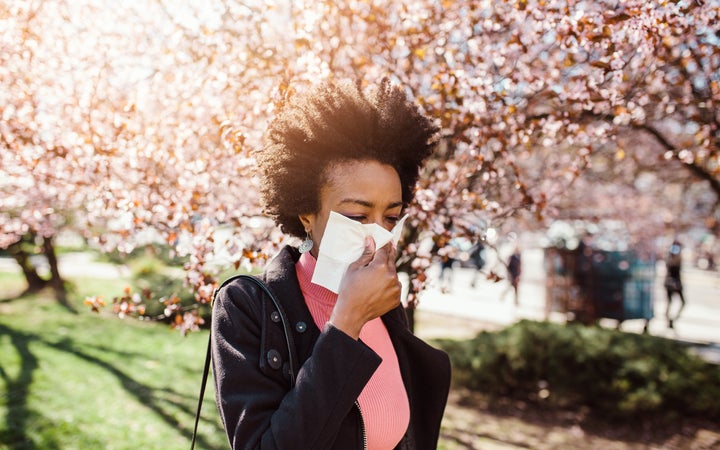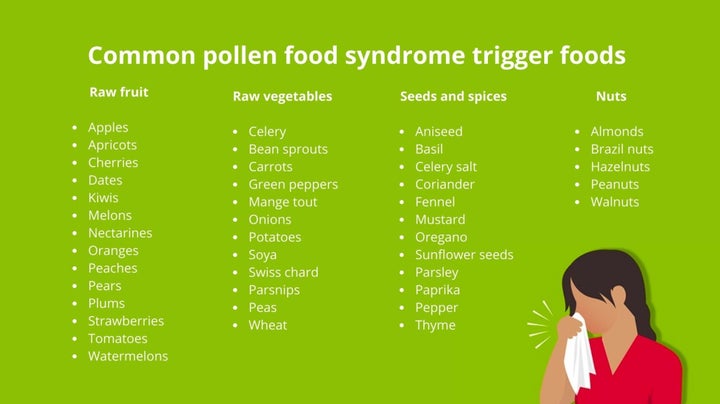
Nearly all of us know someone who has hay fever or perhaps we suffer from hay fever ourselves. Have you heard of pollen food syndrome though? Probably not, although it affects 1 in 50 people.
As we hit hay fever season, GP at Lloyds Pharmacy Online Doctor, Dr. Sabah Salman, explains what the condition is, the main trigger foods, and what we can do if we think we might have pollen food syndrome.
What is pollen food syndrome?
Pollen food syndrome (PFS) is a hypersensitivity reaction to plant-based foods like fruits, vegetables, and nuts, it’s also referred to as oral allergy syndrome.
When people with this condition eat these foods in their raw form, it can cause mild irritant symptoms including itching of the mouth, lips, and throat,” Dr. Salman says.
How common is pollen food syndrome?
“Pollen food syndrome affects around 1 in 50 adults in the UK. Often, it occurs in people who get spring or summertime hay fever, although this is not always the case,” Salman explains.
What causes pollen food syndrome?
Various plant-based foods, such as fruit and cereals, have a protein structure that is very similar in shape to the pollen in the sorts of trees, grasses, and weeds that cause hay fever.
“Your immune system doesn’t always recognise the difference between the pollen you breathe in from things like trees, and the pollen structure in the plant-based foods you eat,” Dr. Salman adds.
She continues: “Essentially, pollen food syndrome results when the immune system recognises the food protein you eat as an allergen and creates an allergic reaction, resulting in similar symptoms to hay fever.”
Which foods cause pollen food syndrome?
Fresh fruit, raw vegetables, and raw nuts are typically the kinds of foods that trigger pollen food syndrome.
“Although almost any fruit, vegetable, or nut can cause a reaction, in particular, raw apples, fresh peaches, kiwi, hazelnuts, and almonds are common triggers. On average, those with pollen fruit syndrome will need to avoid four plant foods,” she adds.
Common pollen food syndrome trigger foods

What are the symptoms of pollen food syndrome?
Symptoms tend to be mild and start within 10 minutes of eating the allergic food. “These symptoms can include redness, itching, and mild swelling of the lips, tongue, inside of the mouth, ears, and throat,” Salman says.
“Some people notice symptoms from food preparation online. “For example, food particles in the air can trigger sneezing, a runny nose, and eye irritation, and peeling fruit and vegetables may cause skin irritation,” she adds.
“Although rare, more extreme symptoms like nausea, vomiting, trouble swallowing, and breathing difficulties can occur. Of course, in this case, you should always seek urgent medical treatment,” she adds.
What should I do if I have a reaction?
Usually, mild pollen food syndrome symptoms settle within an hour, without treatment. “All you will need to do is stop eating the food and drink some water to stop the symptoms. Salman explains.
But if you’re worried or your symptoms are unpleasant, you could also take a non-sedating antihistamine.
“If you have taken an antihistamine but your symptoms are not improving, you should seek medical advice,” she says.
“If you have a food allergic reaction which affects your breathing or circulation, for example, causing faintness, do not rely on antihistamines or an asthma inhaler. Instead, speak to a medical provider urgently,” she adds.
How can I prevent reactions?
You can prevent reactions by avoiding allergenic food in its raw form. “Once well cooked or tinned, the allergens will have been denatured and should not cause an issue,” Dr. Salman says.
“This means a soup containing allergic food may not cause symptoms but a stir-fried vegetable - which has been very gently cooked - may be an issue,” she adds.
Some people may find that they can tolerate certain varieties of the same food. “For example, one variety of apple may cause reactions, whereas another may not. “If food preparation triggers your symptoms, wearing gloves or peeling allergic foods under running water can be an effective workaround,” Dr. Salman explains.
If you find that you have to cut out triggering plant foods make sure you’re replacing them with other tolerated foods. “You still need to aim to eat at least five different portions of fruit and vegetables a day to ensure your diet remains high in fibre, vitamins and minerals,” she adds.
If you feel like you’re experiencing symptoms of pollen food syndrome, make a doctor’s appointment.
“Often, pollen food syndrome can be diagnosed without further testing. However, you may be referred to have a blood test or skin prick testing to confirm a diagnosis,” Dr. Salman says.